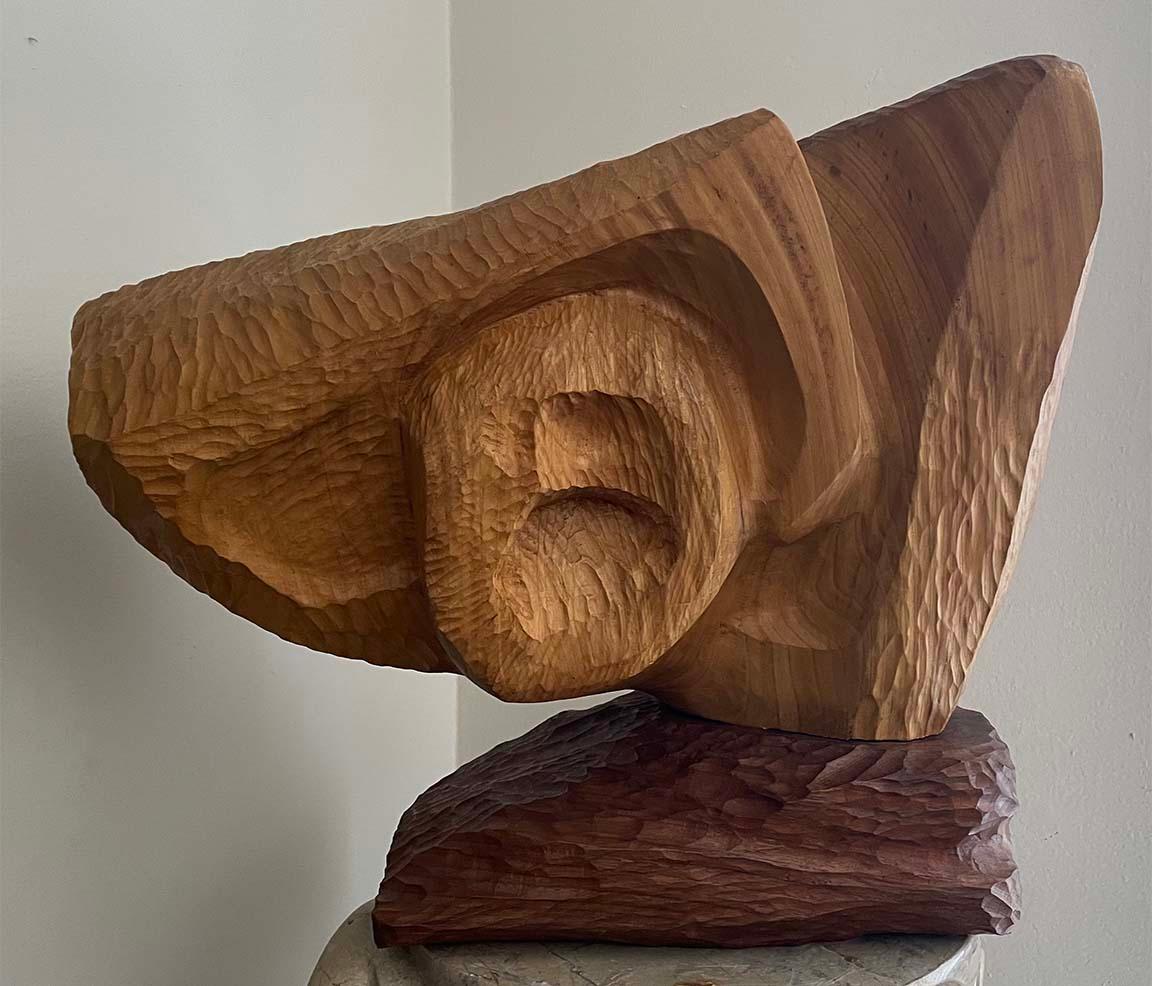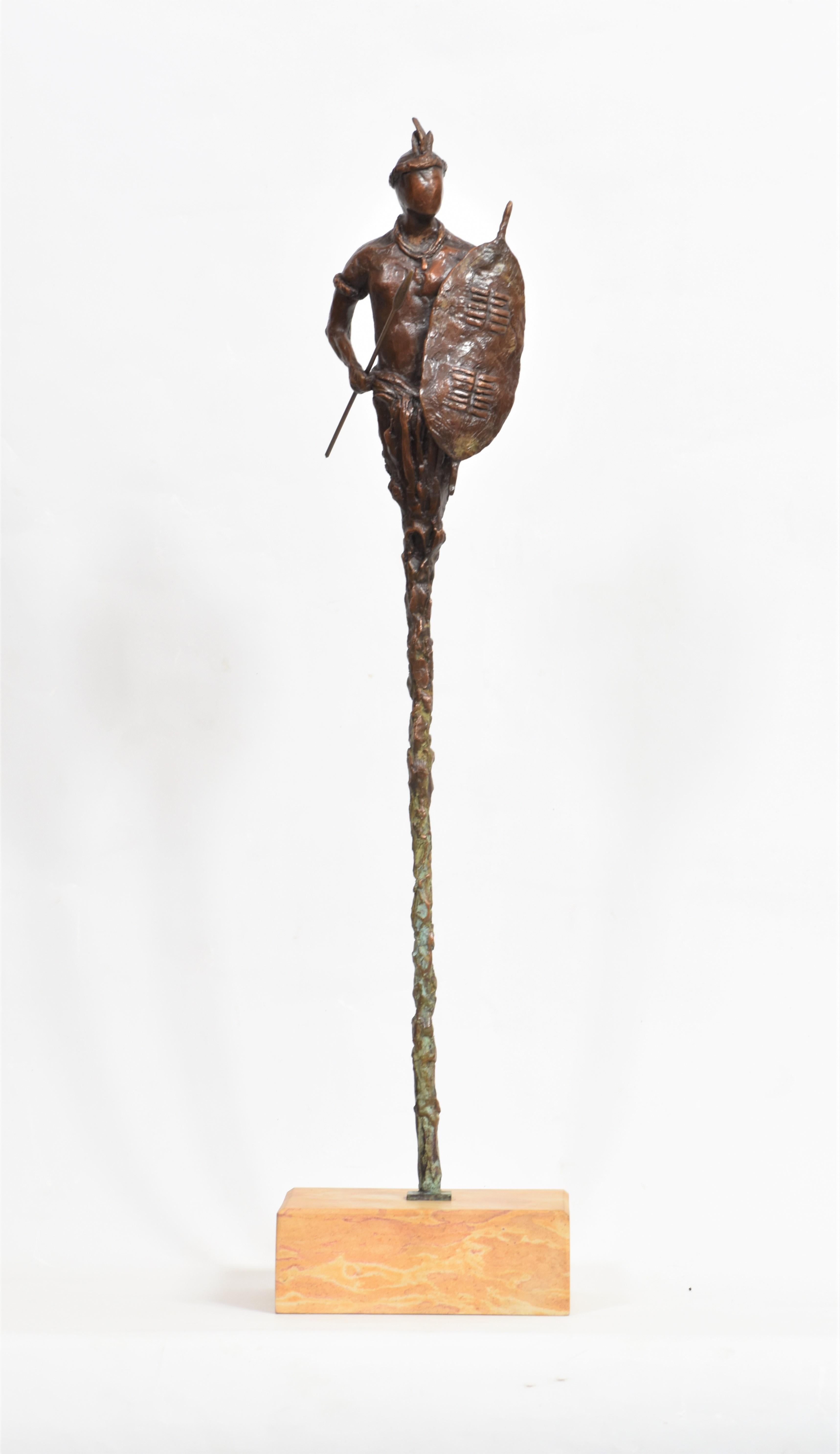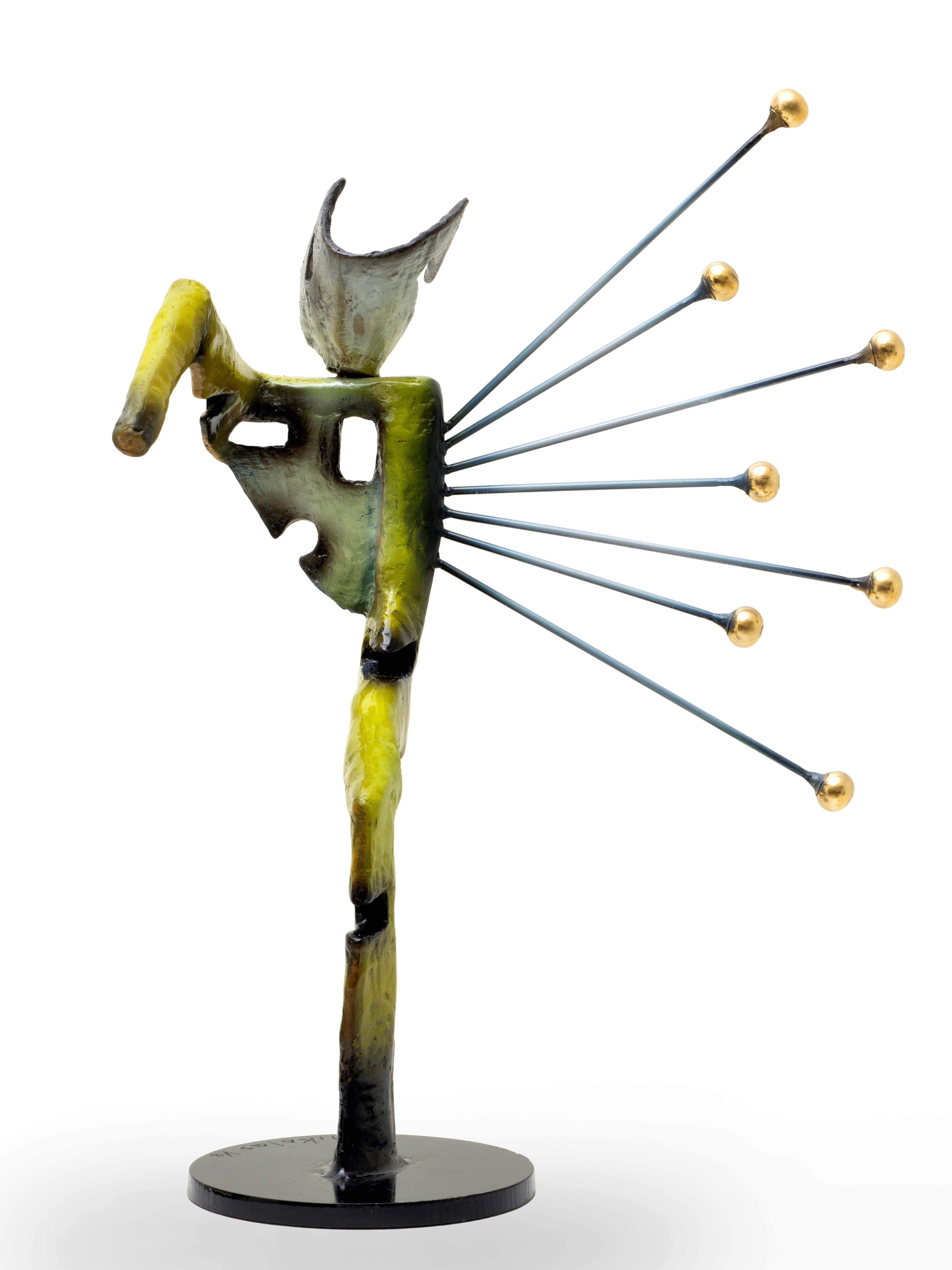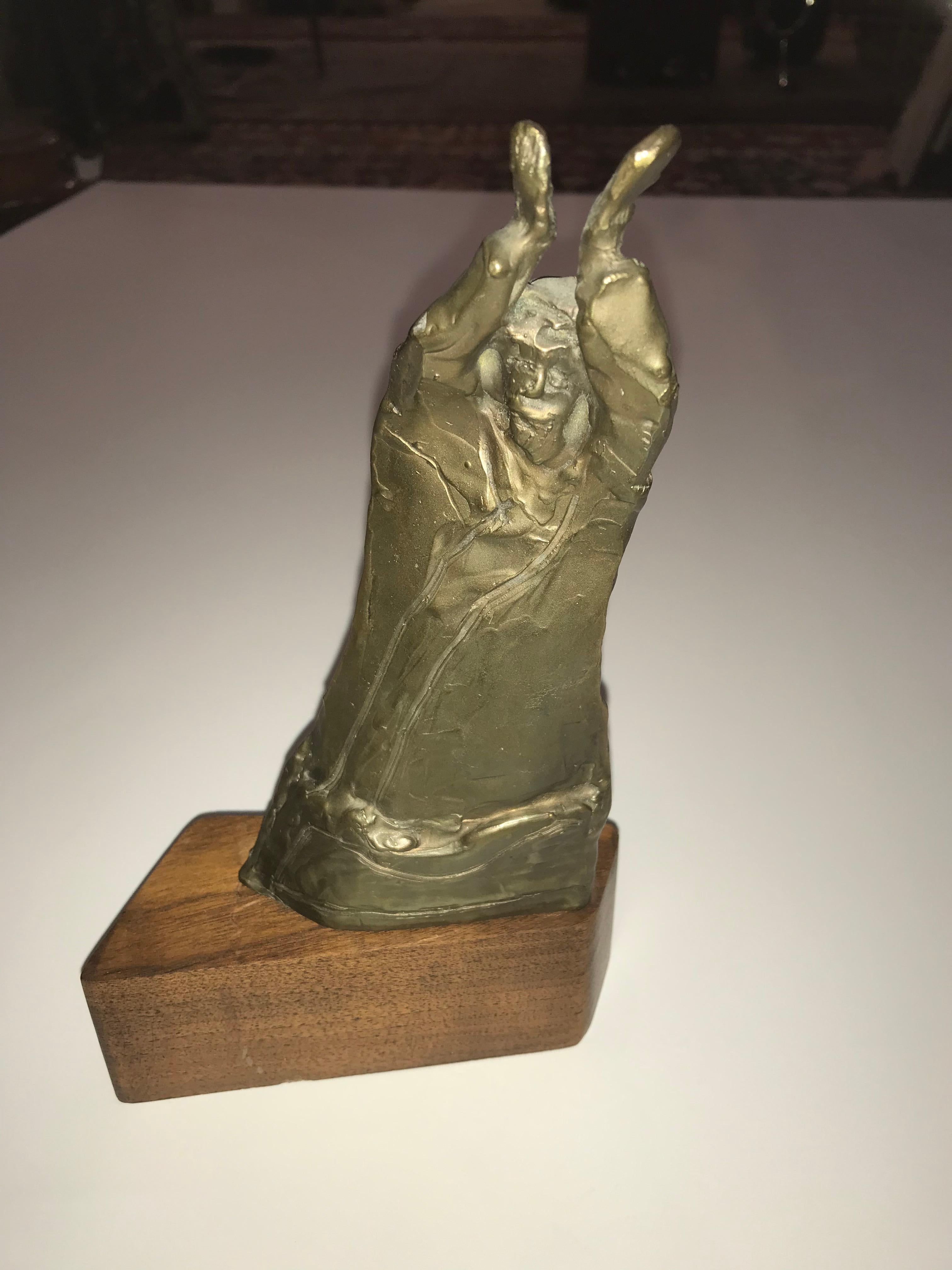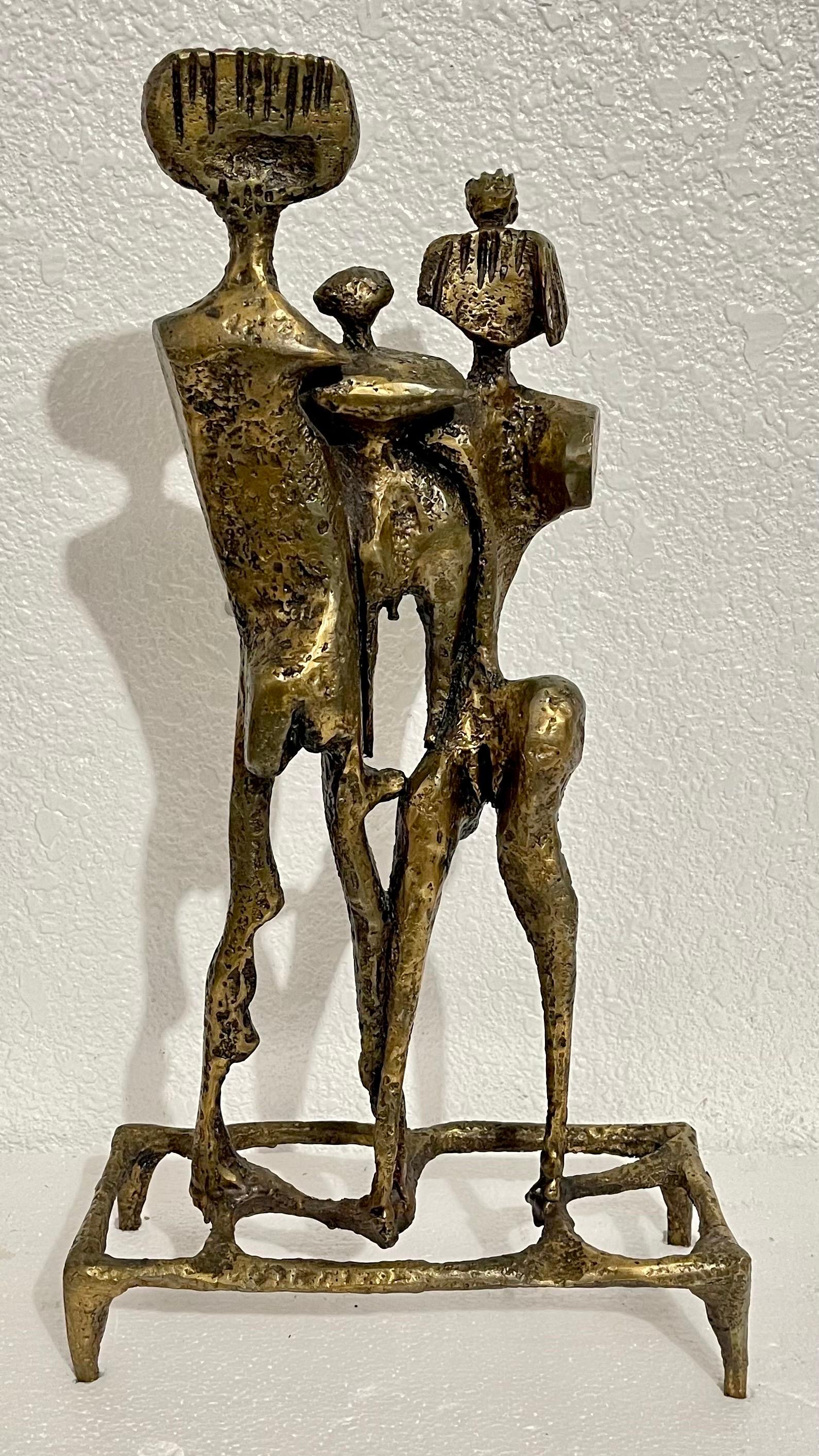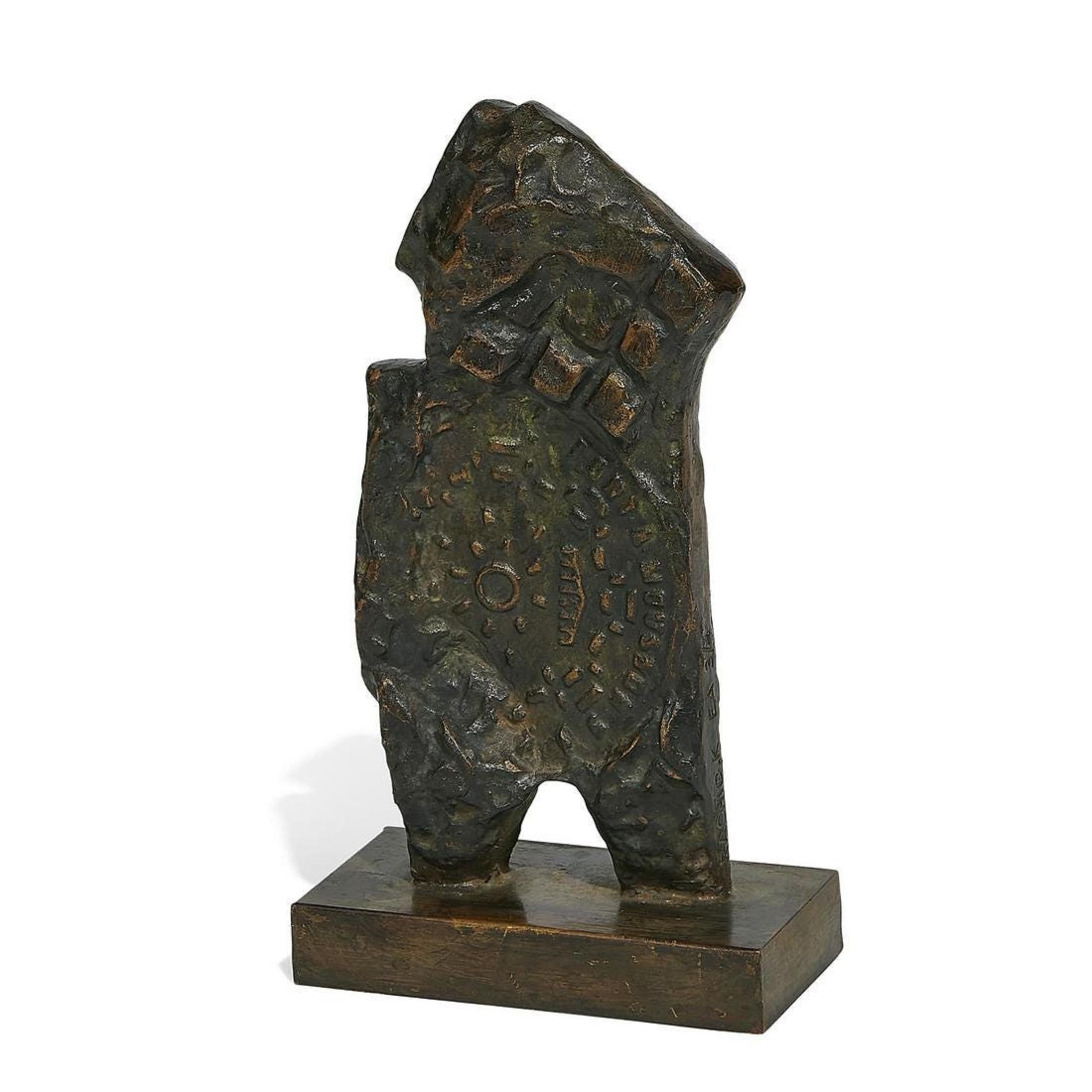Items Similar to Carved Wood German Expressionist Sculpture Jewish Woman Refugee Artist Judaica
Want more images or videos?
Request additional images or videos from the seller
1 of 13
Miriam SommerburgCarved Wood German Expressionist Sculpture Jewish Woman Refugee Artist Judaicac.1950s
c.1950s
About the Item
Miriam Sommerburg (American female artist, born Germany, Hamburg, 1900–1980 New York)
Modernist Wood Carved Sculpture, Carving depicting a family group.
Before being forced to flee Germany during the outbreak of World War II, Miriam Sommerburg had an established career as a prominent and sought-after woodcut artist. There she studied with Richard Luksch (he belonged to the group around Gustav Klimt and left the Wiener Sezession with him in 1905. Created works for the Wiener Werkstatte) and Friederich Alder. Ultimately, she settled in the United States and began to explore a vast range of materials and techniques, including oil painting, watercolor, other methods of printmaking, and wood carving sculpture. At times, she applied her woodblock techniques to these new media—for example, by using incisions to add texture to a painting. Sommerberg was interested in exploring relationships and human emotions, which did not waver through her move. She famously said, “Art doesn’t belong on a pedestal. It belongs to the ordinary people and should be treated honestly.”
Sommerburg would find international renown and go on to have her works displayed at the Boston Art Museum, the 1964 World’s Fair in New York City and the United States Holocaust Memorial Museum. and the Ghetto Fighters House Archives at Kibbutz Lohamei Hagetaot, a community of Holocaust refugees and survivors, among them fighters of the ghetto undergrounds and partisan units in Israel.
In 1944, as the Allies continued to gain ground in Europe and the Nazi atrocities came to light, President Franklin D. Roosevelt allowed 1000 refugees into the country as personal guests. These guests would be staying at Fort Ontario in the city of Oswego, New York. Refugees came from Italy, Germany, and many other countries throughout Europe. Miriam was one of those refugees who stayed at the fort in the 1940s. Miriam Sommerburg went to Greenwich Village New York after the Shelter closed in 1946 and produced an impressive body of work. She held nine one woman shows, won numerous prizes and watched her work being added to the permanent collections of several museums, including the New York Metropolitan Museum of Art.
She studied with Richard Luksich and Friedrich Adler. She exhibited at Syracuse Museum, California Society of Etchers, Society of American Graphic Art, Allied Art of America, Audubon Artists, National Association of Women Artists, Boston Art Museum and was invited to participate in the Ford Foundation Grants and the Academy of Arts & Letters.
- Creator:Miriam Sommerburg (1908 - 1980, German)
- Creation Year:c.1950s
- Dimensions:Height: 13 in (33.02 cm)Width: 12 in (30.48 cm)
- Medium:
- Movement & Style:
- Period:
- Condition:good. minor wear commensurate with age.
- Gallery Location:Surfside, FL
- Reference Number:1stDibs: LU3826376382
About the Seller
4.9
Platinum Seller
These expertly vetted sellers are 1stDibs' most experienced sellers and are rated highest by our customers.
Established in 1995
1stDibs seller since 2014
1,543 sales on 1stDibs
Typical response time: 1 hour
- ShippingRetrieving quote...Ships From: Surfside, FL
- Return PolicyA return for this item may be initiated within 3 days of delivery.
More From This SellerView All
- Large Aharon Bezalel Israeli Modernist Bronze Brutalist Puzzle Sculpture FiguresBy Aharon BezalelLocated in Surfside, FLAharon Bezalel (Afghani-Israeli, 1925-2012) Family Grouping Hand signed in with initials in English Figures fit together like puzzle pieces in solid cast bronze with original patina. Aharon Bezalel (born Afghanistan 1926) Born in Herat, Afghanistan in 1926 and immigrated to Israel at an early age. His father, Reuven Bezalel, was a rabbi and kabbalist. As a youth Aharon studied gold and silver casting as well as applied arts and worked in these fields as a silversmith and judaica craftsman, and was a student of the sculptor Zev Ben-Zvi at the Bezalel Academy for Art & Design where he also studied with Isidor Ascheim and Mordecai Ardon. There he absorbed the basic concepts of classic and modernist art and interpreted, according to them, ideas based on ancient Hebrew sources. He also studied miniature carving with the artists Martin and Helga Rost applying himself at their workshop. Aharon Bezalel worked and resided in Jerusalem, he taught art for many years. His sculptures - works of wood, bronze, aluminum, Plexiglas - were shown at his studio in Ein Kerem. “I saw myself as part of this region. I wanted to find the contact between my art and my surroundings. Those were the first years of Jean Piro’s excavations at the Beer-Sheba mound. They found there, for example, the Canaanite figurines that I especially liked and that were an element that connected me with the past and with this place.” “…a seed and sperm or male and female. These continue life. The singular, the individual alone, cannot exist; I learned this from my father who dabbled with the Kabbalah.” (Aharon Bezalel, excerpt from an interview with David Gerstein) “The singular in Aharon Bezalel’s work is always potentially a couple if not a threesome, the one is also the many: when the individual is revealed within the group he will always seek a huddling, a clinging together. The principle of modular construction is required by this perception of unity and multiplicity, as modular construction in his work is an act of conception or defense. His work bears a similarity to Berrocal as well as affinities to Henry Moore, Lynne Chadwick and Kenneth Armitage. Two poles of unity, potentially alone, exist in A. Bezalel’s world: From a formal, sculptural sense these are the sphere and pillar, metaphorically these are the female in the final stages of pregnancy and the solitary male individual. Sphere-seed-woman; Pillar-strand-man. The disproportional, small heads in A. Bezalel figures leave humankind in it’s primal physical capacity. The woman as a pregnancy or hips, the man as an aggressive or defensive force, the elongated chest serves as a phallus and weapon simultaneously. (Gideon Ofrat) EIN HAROD About the Museum's Holdings: Israeli art is represented by the works of Reuven Rubin, Zaritzky, Nahum Gutman...Category
Mid-20th Century Expressionist Abstract Sculptures
MaterialsBronze
- Rachid Khimoune French Algerian Arab Art Brut Bronze Sculpture Abstract FigureLocated in Surfside, FLRachid Khimoune (Algerian, b. 1953) Les enfants du monde bronze. signed and numbered artist's edition of 4 foundry mark - L. Cappe 7.5 x 4.63 x 2.38 Overall: 8.25 x 4.63 x 2.38 RACHID KHIMOUNE, Algerian-French artist and sculptor. Born in 1953 in Decazeville, France. Lives and works in Paris, France. Rachid Khimoune graduated from the School of Art of Paris in 1974; he initially started to work with painting before choosing sculpture. In 1980 he won the first prize of the Foundation of France. He works in an Art Brut, Naif art style similar to Jean Dubuffet and Enrico Baj. Being the recipient of numerous prestigious awards and an extensive oeuvre, Rachid Khimoune has been exhibiting since 1975 and his work can be found in several museums, and public and private collections. The artist behind the project Rachid Khimoune, has been responsible for a number of major, successful public art installations in France. Most famously, the installation close to the Bibliothèque Nationale (National Library) ‘Les Enfants du Monde’ (The Children of the World). Rachid’s newer works are masks and totems cast in bronze: poetic images forged in a furnace. Rachid uses discarded objects and disused parts of machines, to create new human and animal forms. Here his interest in metal-working and Arab art-African art coincides with the assemblage of found objects; one mask is a collage constituted by a large model of the Eiffel Tower stuck into the end of a trumpet. Another has a jerry-can for a face, and the golden patina and surface-working of the bronze does not dispel the idea which this image creates: of a human mouth drinking oil. Born in France to parents from Algeria, Khimoune embraces the role of the artist as a global citizen, using art as a universal language. Select Awards Lauréat du Prix de la Fondation de France (1980) Chevalier des Arts et Lettres (2002) Grande Médaille de la Ville de Paris (2004) Chevalier de la Légion d’Honneur (2007) EXHIBITIONS SOLO EXHIBITIONS 2017 Ar[T]senal, Dreux, France 2016 Musée Tavet Delacour, Pontoise, France 2015 Parvis de l’Hotel de ville, Paris 2015 Beirut Art Fair, Beyrouth, Liban 2015 Galerie Francoise Souchaud, Lyon 2014 Musée Rabelais, Seuilly, France 2013 Galerie Vallois...Category
20th Century Expressionist Abstract Sculptures
MaterialsBronze
- Liberty vs Slavery Van Loen Bronze Abstract Chess Set Modernist Museum SculptureBy Alfred Van LoenLocated in Surfside, FLAlfred Van Loen signed 32 piece chess set. In heavy solid bronze. Rare Chess Game: Liberty versus Slavery Dimensions: a) Joy-Tenderness H. 6 3/16 in. a...Category
1960s Expressionist Abstract Sculptures
MaterialsBronze
- Large Aharon Bezalel Israeli Modernist Bronze Brutalist Puzzle Sculpture FiguresBy Aharon BezalelLocated in Surfside, FLAharon Bezalel (Afghani-Israeli, 1925-2012) 1984 Edition 4/9 Family Grouping Hand signed in Hebrew with initials and in English Movable figures that fit together like puzzle pieces in solid cast bronze with original patina on a lucite bench base. 23 X 19 X 6 base is 24 X 6 X 6 Aharon Bezalel (born Afghanistan 1926) Born in Herat, Afghanistan in 1926 and immigrated to Israel at an early age. His father, Reuven Bezalel, was a rabbi and kabbalist. As a youth Aharon studied gold and silver casting as well as applied arts and worked in these fields as a silversmith and judaica craftsman, and was a student of the sculptor Zev Ben-Zvi at the Bezalel Academy for Art & Design where he also studied with Isidor Ascheim and Mordecai Ardon. There he absorbed the basic concepts of classic and modernist art and interpreted, according to them, ideas based on ancient Hebrew sources. He also studied miniature carving with the artists Martin and Helga Rost applying himself at their workshop. Aharon Bezalel worked and resided in Jerusalem, he taught art for many years. His sculptures - works of wood, bronze, aluminum, Plexiglas - were shown at his studio in Ein Kerem. “I saw myself as part of this region. I wanted to find the contact between my art and my surroundings. Those were the first years of Jean Piro’s excavations at the Beer-Sheba mound. They found there, for example, the Canaanite figurines that I especially liked and that were an element that connected me with the past and with this place.” “…a seed and sperm or male and female. These continue life. The singular, the individual alone, cannot exist; I learned this from my father who dabbled with the Kabbalah.” (Aharon Bezalel, excerpt from an interview with David Gerstein) “The singular in Aharon Bezalel’s work is always potentially a couple if not a threesome, the one is also the many: when the individual is revealed within the group he will always seek a huddling, a clinging together. The principle of modular construction is required by this perception of unity and multiplicity, as modular construction in his work is an act of conception or defense. His work bears a similarity to Berrocal as well as affinities to Henry Moore, Lynne Chadwick and Kenneth Armitage. Two poles of unity, potentially alone, exist in A. Bezalel’s world: From a formal, sculptural sense these are the sphere and pillar, metaphorically these are the female in the final stages of pregnancy and the solitary male individual. Sphere-seed-woman; Pillar-strand-man. The disproportional, small heads in A. Bezalel figures leave humankind in it’s primal physical capacity. The woman as a pregnancy or hips, the man as an aggressive or defensive force, the elongated chest serves as a phallus and weapon simultaneously. (Gideon Ofrat) EIN HAROD About the Museum's Holdings: Israeli art is represented by the works of Reuven Rubin, Zaritzky, Nahum Gutman...Category
Mid-20th Century Expressionist Abstract Sculptures
MaterialsBronze
- Karel Appel Colorful Expressionist Hand Painted Wood Cobra Sculpture Pop ArtBy Karel AppelLocated in Surfside, FLThis is an original wooden sculpture with hand painting on both sides. it does not appear to be signed or numbered and does not currently have any label. I believe this might be the proof, There was an edition of these and this is a unique variant. All done by hand. It is on a base and revolves and rotates easily as there are ball bearings. It is very well made. Christiaan Karel Appel (1921-2006) was a Dutch artist, painter, sculptor, and poet. Born in Amsterdam, the Netherlands, he died in Zurich, Switzerland. He started painting at the age of fourteen and studied at the Rijksakademie in Amsterdam in the 1940s. He was one of the founders of the avant-garde movement Cobra in 1948. He was also an avid sculptor and has had works featured in MoMA, the Stedelijk and other museums worldwide. At fourteen, Appel produced his first real painting on canvas, a still life of a fruit basket. For his fifteenth birthday, his wealthy uncle Karel Chevalier gave him a paint set and an easel. An avid amateur painter himself, Chevalier gave his namesake some lessons in painting. From 1940 to 1943, during the German occupation, Appel studied at the Rijksakademie van Beeldende Kunsten in Amsterdam, and it was there he met the young painter Guillaume Corneille and, some years later, Constant; they became close friends for years. Appel had his first show in Groningen in 1946. In 1949 he participated with the other CoBrA artists in the Stedelijk Museum Amsterdam; this generated a huge scandal and many objections in the press and public. He was influenced by Pablo Picasso, Henri Matisse, and the French brute-art artist Jean Dubuffet. In 1947 he started sculpting with all kinds of used materials (in the technique of assemblage) and painted them in bright colors: white, red, yellow, blue, and black. He joined the Experimentele Groep in Holland together with the young Dutch painters Anton Rooskens...Category
1970s Abstract Expressionist Abstract Sculptures
MaterialsWood, Paint
- Large Bronze Modernist Biomorphic Sculpture Sleeping Dog Colin Webster WatsonLocated in Surfside, FLSculpture Of A Sleeping Dog. A wonderful and realistic cast bronze signed and numbered. With beautiful weathered patina Small edition of 10 Colin Webs...Category
1970s Abstract Sculptures
MaterialsBronze
You May Also Like
- The ScreamLocated in Los Angeles, CAJOAN STRAUSS CAROL "THE SCREAM" WOOD, SIGNED, TITLED CALIFORNIA, DATED 1984 1575 X 19 INCHES Joan Strauss Carl 1926-2021 Joan Strauss Carl was...Category
1980s Expressionist Figurative Sculptures
MaterialsWood
- Zulu Warrior - African Bronze Sculpture - Limited EditionLocated in Pretoria, ZAZulu Warrior in Bronze with traditional patina. Limited edition of 24 (signed & numbered), Sculpture in Bronze Verdigris on Sandstone base. Height 70 cm including base. My art is ins...Category
2010s Expressionist Figurative Sculptures
MaterialsSandstone, Bronze
- HomodeusLocated in Spetses, GRInspired by the writings of historian Yuval Noah Harari, Homo Deus creates a vision of the future: of Man physically transformed by new technologies to the point of attaining a statu...Category
21st Century and Contemporary Expressionist Abstract Sculptures
MaterialsBronze
- Standing Man by Mildred KouzelLocated in Pasadena, CAOriginal Art Work By California Recent Artist Standing Man, 1981 Mildred Kouzel's first career was in nursing: she was an army nurse during World War II...Category
Mid-20th Century Expressionist Figurative Sculptures
MaterialsBronze
- Vintage Figurative Abstract Tribal Creature Head SculptureBy Nathaniel SirlesLocated in Soquel, CAEvocative figurative abstract sculpture of the head of a tribal creature by Nathaniel Sirles (American, b. 1954). Signed and dated "N. Sirles 1970" on the bottom. Sirles completed th...Category
1970s Expressionist Figurative Sculptures
MaterialsStone
- Four-Armed Man with Drum, Tribal Figurative Abstract SculptureBy Nathaniel SirlesLocated in Soquel, CAFigurative abstract tribal sculpture of a creature with four arms by Nathaniel Sirles (American, b. 1956). Signed and dated "Sirles 1973" on the bottom. Sirles completed this piece ...Category
1970s Expressionist Figurative Sculptures
MaterialsStone, Alabaster
Recently Viewed
View AllMore Ways To Browse
Mid Century Light Sculpture
German Wood Sculpture
Carved Italian Wood Sculptures
Wood Letters
Female Wood Sculpture
Carved Sculpture Woman
Modernist Wood Sculpture
Carved Wood Female
Wood Woman Carved
Women Sculptures Italian
Italian Modernist Sculpture
Carved Wood Female Sculpture
Jewish Wood
1950s German Modernist
Modernist Carved Sculpture
Wood Pedestal For Sculpture
Werkstatte Sculpture
Light Wood Pedestals
